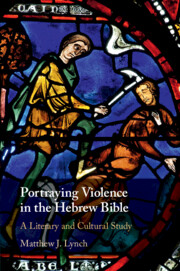Book contents
- Portraying Violence in the Hebrew Bible
- Portraying Violence in the Hebrew Bible
- Copyright page
- Publisher’s note
- Dedication
- Contents
- Acknowledgements
- Abbreviations
- Introduction
- Part I Violence and Ecology
- 1 A Brother’s Blood on the Land
- 2 The Cosmic Ecology of Violence
- 3 Covenant and the Restraint of Violence in Creation
- Part II Violence and Moral Speech
- Part III Violence and Justice
- Part IV Violence and Impurity
- Conclusion
- Appendix
- Bibliography
- Index
3 - Covenant and the Restraint of Violence in Creation
from Part I - Violence and Ecology
Published online by Cambridge University Press: 06 May 2020
- Portraying Violence in the Hebrew Bible
- Portraying Violence in the Hebrew Bible
- Copyright page
- Publisher’s note
- Dedication
- Contents
- Acknowledgements
- Abbreviations
- Introduction
- Part I Violence and Ecology
- 1 A Brother’s Blood on the Land
- 2 The Cosmic Ecology of Violence
- 3 Covenant and the Restraint of Violence in Creation
- Part II Violence and Moral Speech
- Part III Violence and Justice
- Part IV Violence and Impurity
- Conclusion
- Appendix
- Bibliography
- Index
Summary
Chapter 3 explores divine responses to the ways God responds to the ruptures wrought by violence in the physical world, especially as presented in Genesis 8-9. In Gen 8:22, God assures humanity that he would uphold the cycles of creation in the face of human corruption, such that it would not sustain the impact of violence as it did before the flood. Psalm 74 portrays an analogous world in which God’s ongoing power over creation subdues the chaotic ruin that violence unleashes in the world. I also suggest that God’s promise to never again curse the land reverses the land curse arising from Cain’s act of violence (4:12). This chapter also addresses the ‘laws’ of Gen 9:1-6. Some understand Gen 9:1-6 to address humanity’s bloodlust for violence. God tolerates a modicum of violence against animals, but restrains it. I suggest by contrast that the ‘fear and dread’ reflects the fractured relationship between humans and animals. Also, the so-called ‘laws’ only point toward the need for law, and in the world of the story, indicate only what God himself will do. Moreover, the text restricts humanity’s power over the life(blood) of animals. Finally, the creation covenant (9:7-18) reflects ways that God restricts the use of divine violence in the post-flood world. This creation covenant anticipates God’s later covenants with Israel and the land.
- Type
- Chapter
- Information
- Portraying Violence in the Hebrew BibleA Literary and Cultural Study, pp. 70 - 94Publisher: Cambridge University PressPrint publication year: 2020

